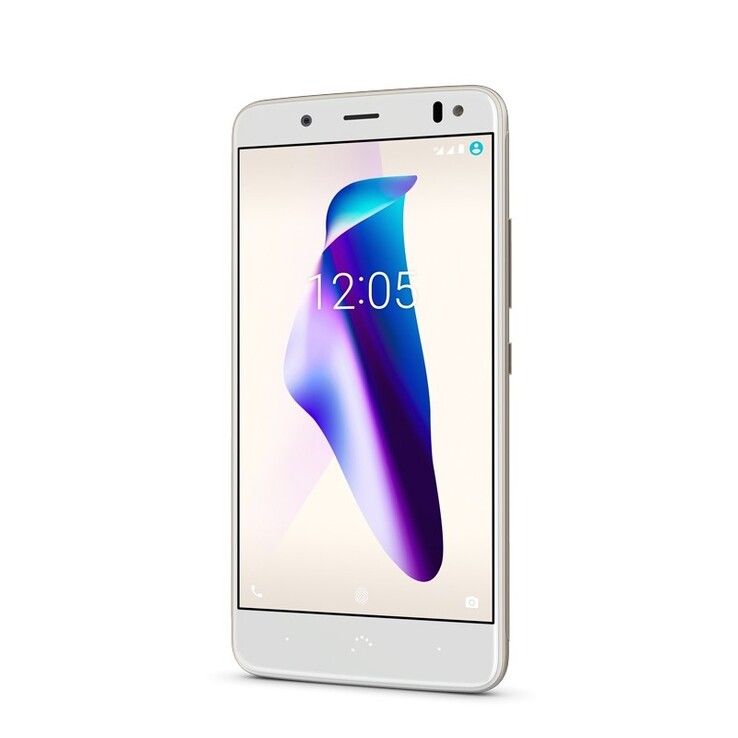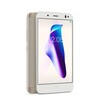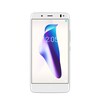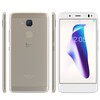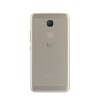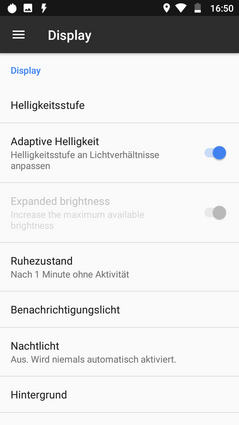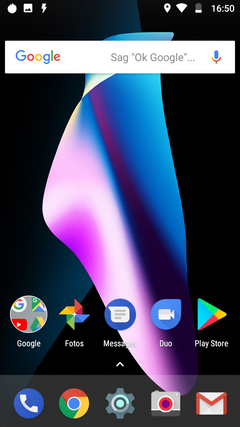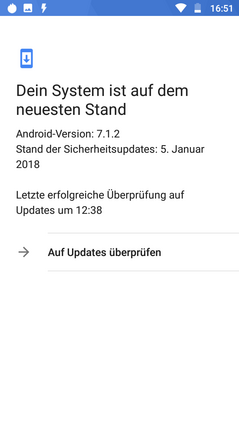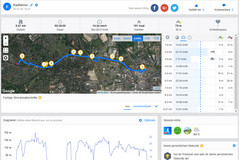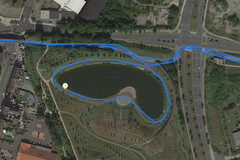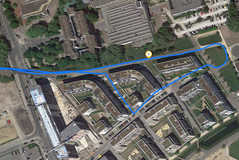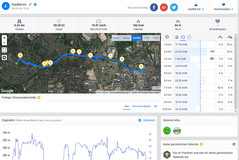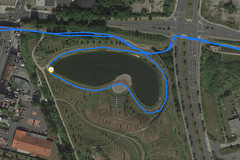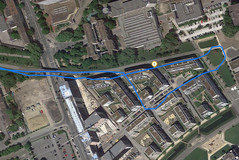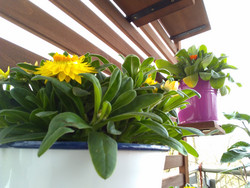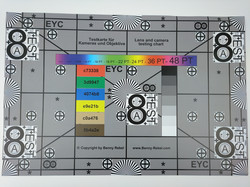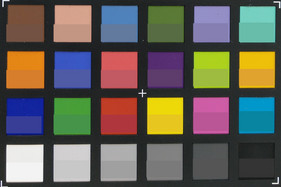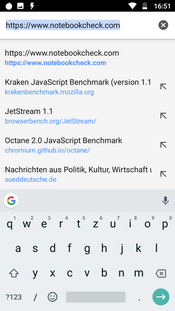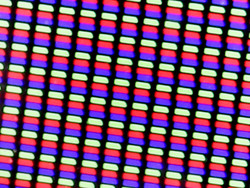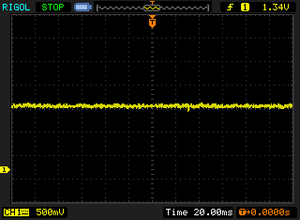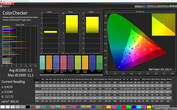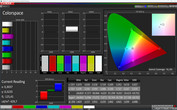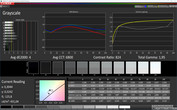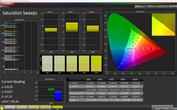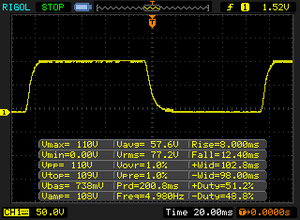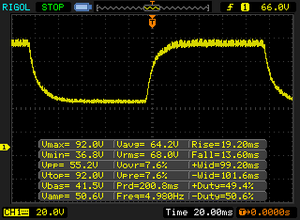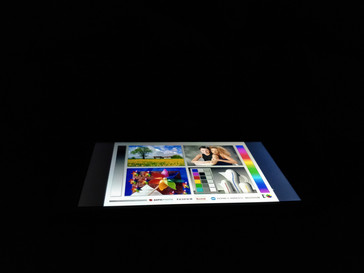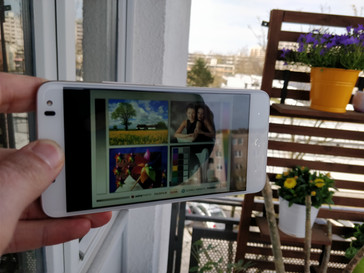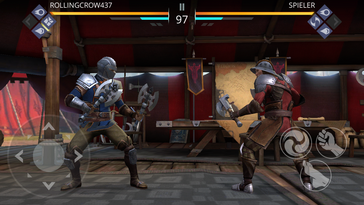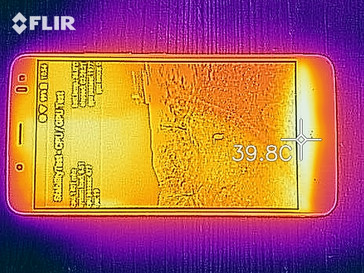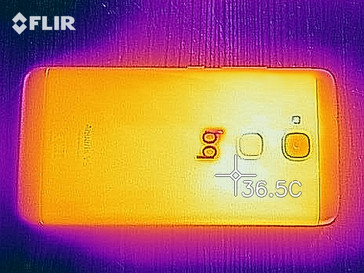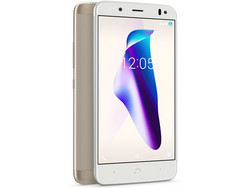BQ Aquaris VS Smartphone Review
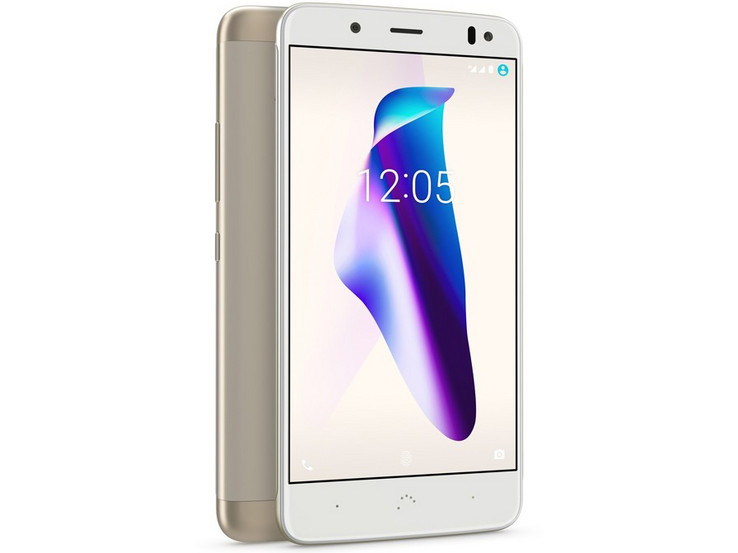
The BQ has sent us the Aquaris VS, a 5.2-inch lower mid-range smartphone that is only available either directly from BQ or from their Amazon store. Compared to the widely available Aquaris V, the Aquaris VS has more internal storage and RAM at the expense of a downgraded SoC. While the Aquaris V is powered by a Qualcomm Snapdragon 435, the Aquaris VS is powered by a Qualcomm Snapdragon 430, which supports fewer LTE bands and a slower LTE speed. The Aquaris VS is €50 (~$62) cheaper than the Aquaris V, and the trade-offs seem manageable. We will be clarifying in this review whether you should pick up the bargain-priced BQ Aquaris VS.
We will be comparing the Aquaris VS with similarly priced and sized devices such as the Samsung Galaxy J5 (2017) Duos, the Motorola Moto G5s, the Nokia 5, and the Nubia Z17 Mini.
You can also find the reviews for other BQ devices, such as the BQ Aquaris X5, the BQ Aquaris X5 Plus, the BQ Aquaris M5 or the BQ Aquaris X in our database.
Case
The Aquaris VS looks identical to the Aquaris V. There are differences though. The Aquaris VS is only available in white with a gold back, and not black like the Aquaris V. Additionally, the Aquaris VS lacks the IP52 rating against dust and dripping water that the Aquaris V has. It is unclear whether this omission is to save on licensing costs or whether there really is no dust or water protection. The Aquaris VS is still quite heavy at 165 g (~5.8 oz), but stability and ergonomics are still good.
Connectivity
Our test device is equipped with 64 GB of internal storage and 4 GB of RAM. At €220 (~$272), the Aquaris VS is just as expensive as the 16 GB / 2GB RAM variant of the Aquaris V. The 32 GB internal storage and 3 GB RAM Aquaris VS variant is only €20 (~$25) cheaper than our test device variant.
The Aquaris VS is a dual-SIM device with microSD card expansion. There is support for either two nano-SIMs or one nano-SIM and a microSD card. The Aquaris VS cannot be used with two nano-SIMs and a microSD card simultaneously. It is worth bearing in mind that while you can format a microSD card as internal storage, doing so prevents you from using the card in any other device until it is re-formatted.
Software
BQ list the Aquaris VS as shipping with Android 7.1.2 Nougat, but our test device received this update shortly after we set up the device. The Android security patches were slightly outdated at the time of testing being dated January 2018. While BQ has announced that the Aquaris VS will receive an update to Android 8 Oreo, there is currently no set date.
Android purists will be happy with the Aquaris VS as it runs practically stock Android. There is only one additional pre-installed app, which advertises BQ’s mobile phone insurance.
Communication and GPS
The Aquaris VS is as equally well equipped in terms of Wi-Fi connectivity as the Aquaris V. The Aquaris VS supports 802.11 a/b/g/n/ac standards, which in practical terms means that the Aquaris VS can connect to 5 GHz and 2.4 GHz Wi-Fi networks. The Aquaris VS performs well for a lower mid-range Android smartphone. We measured performance using our reference Linksys EA8500 router. The Aquaris VS has full Wi-Fi reception when next to the router, but websites still need some time to fully load. Signal strength reduces by half with our test device ten meters (~33 ft) and three walls from the router. Websites take longer to load too, which should be expected when in areas of weaker reception. The main difference between the Aquaris VS and Aquaris V in this respect is the degree of signal degradation when the devices are some way from the router.
The Aquaris VS and Aquaris V perform equally well in terms of maximum LTE speed. The Aquaris VS supports only four LTE bands, those that are necessary for coverage across Central Europe. This means that the Aquaris VS supports fewer LTE bands than its sibling, something which should be considered if you regularly travel outside of this relatively small area. The Aquaris VS had good reception on the D2 network in Germany, even in buildings.
| Networking | |
| iperf3 transmit AX12 | |
| Samsung Galaxy J5 (2017) Duos | |
| Nubia Z17 mini | |
| BQ Aquaris VS | |
| BQ Aquaris V | |
| Nokia 5 | |
| Motorola Moto G5s | |
| iperf3 receive AX12 | |
| Nubia Z17 mini | |
| BQ Aquaris V | |
| BQ Aquaris VS | |
| Samsung Galaxy J5 (2017) Duos | |
| Nokia 5 | |
| Motorola Moto G5s | |
The GPS module could not locate us indoors, even when next to a window. The Aquaris VS is accurate to within three meters (~10 ft) outside though, which is very impressive.
We pitted the Aquaris VS against the Garmin Edge 500, our reference professional navigation system, on a bike ride to test the Aquaris VS’ GPS accuracy in practical terms. We measured a forty-meter (~141 ft) difference between the two devices, which makes the Aquaris VS a very accurate device. The route around the lake demonstrates the Garmin Edge 500’s greater accuracy, but the Aquaris VS remained mostly accurate. Noticeably, when riding between tall buildings, the Aquaris VS was more accurate than the Garmin Edge 500. As a result, we recommend the Aquaris VS for those who need a smartphone suitable for navigation.
Phone Function and Call Quality
The Aquaris VS uses the Google Phone app as part of its near stock implementation of Android. The Google Phone app is easy to use with many features that are quick to access. The Aquaris VS lacks VoLTE support.
Unsurprisingly, call quality is like that of the Aquaris V. Calls sound clear on our test device, but the microphone distorts loud voices. This is the case on speaker too. This microphone distortion required us to speak softly so that the person on the other end of the call could clearly hear us.
Cameras
The Aquaris VS uses the same camera sensors as the Aquaris V. There is a 12 MP Sony IMX386 sensor on the rear and an 8 MP Samsung S5K4H8 front-facing camera sensor. The rear-facing camera performs poorly in low light and produces very dark results. The Aquaris VS performs well in daylight conditions, taking photographs with adequate details and color reproduction. These were all slightly underexposed for our liking though. Naturally, the Aquaris VS cannot match the performance of much more expensive devices like the iPhone X, but nor should it be expected to, considering the huge difference in price between the two devices.
The Aquaris VS can record videos at up 1080p and at 30 frames per second. In regular lighting conditions, videos are well exposed with good sharpness. There is significant blurriness in low-light conditions though.
Front-facing camera performance is ok. While shots are sharp when at the correct distance, there could be better dynamic range in bright and dark areas of images.
We then tested the Aquaris VS in our laboratory under standardized lighting conditions. Our test device performed admirably, with good colour accuracy and few visible artefacts. Text looked sharp against a colored background while overall, the main-camera made pictures look quite sharp.
Accessories and Warranty
We have not had a smartphone in for review without a power supply for a long time. Most devices still come with a USB power supply and are often interchangeable thanks to standards like QuickCharge. The Aquaris VS only comes with a USB cable and SIM tool in the box, presumably to save on costs. An official BQ charger costs around €15 (~$18) online. There are cases and screen protectors on the BQ online store too.
BQ provides a 24-month warranty for all its smartphones. Please see our Guarantees, Return Policies and Warranties FAQ for country-specific information.
Input Devices and Operation
Google’s GBoard is the default keyboard. There are many customization options and support within the keyboard for Google Assistant. The default keyboard is replaceable with others like those that are available in the Google Play Store. It is worth bearing in mind though that keyboard apps may tap into your personal data, so choosing a provider that you trust is paramount.
The touchscreen is sensitive to the corners of the display and has a good feel to it. There are white silver hardware touch buttons beneath the display that are visible against the white case at certain angles. The power and volume buttons are on the right-hand side of the case.
There is a fingerprint scanner on the back of the device that we found to be easily accessible with an index finger when using our test device. The fingerprint scanner reliably unlocks the device even from standby.
Display
The Aquaris VS has a 720p display, and one which is slightly darker than the one we reviewed in the Aquaris V. This is only a comparative drawback though as the Aquaris VS has a sufficiently bright display at an average of 544 cd/m². Brightness uniformity is slightly worse than the Aquaris V at 88%, but subjectively, areas of color look uniformly lit. We did not notice any PWM display flicker during our tests either.
| |||||||||||||||||||||||||
Brightness Distribution: 88 %
Center on Battery: 535 cd/m²
Contrast: 877:1 (Black: 0.61 cd/m²)
ΔE ColorChecker Calman: 5.3 | ∀{0.5-29.43 Ø4.78}
ΔE Greyscale Calman: 4 | ∀{0.09-98 Ø5}
Gamma: 1.95
CCT: 6800 K
| BQ Aquaris VS IPS, 1280x720, 5.2" | Samsung Galaxy J5 (2017) Duos Super AMOLED, 1280x720, 5.2" | Nokia 5 IPS, 1280x720, 5.2" | Motorola Moto G5s IPS, 1920x1080, 5.2" | BQ Aquaris V IPS, 1280x720, 5.2" | Nubia Z17 mini IPS, 1920x1080, 5.2" | |
|---|---|---|---|---|---|---|
| Screen | 15% | 3% | 7% | 10% | -20% | |
| Brightness middle (cd/m²) | 535 | 448 -16% | 630 18% | 490 -8% | 578 8% | 405 -24% |
| Brightness (cd/m²) | 544 | 451 -17% | 635 17% | 502 -8% | 583 7% | 406 -25% |
| Brightness Distribution (%) | 88 | 91 3% | 90 2% | 92 5% | 91 3% | 91 3% |
| Black Level * (cd/m²) | 0.61 | 0.57 7% | 0.43 30% | 0.49 20% | 0.61 -0% | |
| Contrast (:1) | 877 | 1105 26% | 1140 30% | 1180 35% | 664 -24% | |
| Colorchecker dE 2000 * | 5.3 | 2.7 49% | 5 6% | 5.7 -8% | 5.4 -2% | 6.5 -23% |
| Colorchecker dE 2000 max. * | 11.1 | 9.8 12% | 8.7 22% | 7.8 30% | 9.1 18% | 9.3 16% |
| Greyscale dE 2000 * | 4 | 1.6 60% | 6.9 -73% | 4.7 -18% | 4.3 -8% | 7.4 -85% |
| Gamma | 1.95 113% | 2.06 107% | 2.37 93% | 2.4 92% | 2.13 103% | 2 110% |
| CCT | 6800 96% | 6557 99% | 8736 74% | 7526 86% | 7400 88% | 8329 78% |
* ... smaller is better
Screen Flickering / PWM (Pulse-Width Modulation)
| Screen flickering / PWM not detected | |||
In comparison: 53 % of all tested devices do not use PWM to dim the display. If PWM was detected, an average of 8108 (minimum: 5 - maximum: 343500) Hz was measured. | |||
We measured the Aquaris VS with a black level of 0.61 cd/m². This is significantly higher than what we measured on the Aquaris V. This high black level affects the contrast ration, which is a rather average 877:1. The display achieves 91% sRGB color space accuracy, but our spectrophotometer and CalMAN software picked out a slight blue tint. Our tests showed that the display has poor colour fidelity, particularly with shades of orange. So, despite the high sRGB color space accuracy, the results of the CalMAN software demonstrate that the Aquaris VS’ display is less than perfect.
Display Response Times
| ↔ Response Time Black to White | ||
|---|---|---|
| 20.4 ms ... rise ↗ and fall ↘ combined | ↗ 8 ms rise | |
| ↘ 12.4 ms fall | ||
| The screen shows good response rates in our tests, but may be too slow for competitive gamers. In comparison, all tested devices range from 0.1 (minimum) to 240 (maximum) ms. » 44 % of all devices are better. This means that the measured response time is similar to the average of all tested devices (20.2 ms). | ||
| ↔ Response Time 50% Grey to 80% Grey | ||
| 32.8 ms ... rise ↗ and fall ↘ combined | ↗ 19.2 ms rise | |
| ↘ 13.6 ms fall | ||
| The screen shows slow response rates in our tests and will be unsatisfactory for gamers. In comparison, all tested devices range from 0.165 (minimum) to 636 (maximum) ms. » 43 % of all devices are better. This means that the measured response time is similar to the average of all tested devices (31.6 ms). | ||
Thanks to its relatively high screen brightness, the Aquaris VS is usable outdoors even in bright sunlight. The brightness sensor reacts quickly and alters screen brightness to suit the conditions. The display has good viewing angles. We noticed minor color shifts at acute angles.
Performance
There are no major performance differences between the Aquaris VS and the Aquaris V. The two devices are powered by different SoCs, namely the Qualcomm Snapdragon 430 in the Aquaris VS and the Qualcomm Snapdragon 435 in the Aquaris V. The Snapdragon 430 and Snapdragon 435 only differ in their LTE modems though so that is why the Aquaris VS and Aquaris V perform similarly.
The Aquaris VS performs marginally worse than most of our other comparison devices. The Nokia 5 and Moto G5s are powered by a Snapdragon 430 too, performing 3% and 5% better than the Aquaris VS respectively. The Samsung Exynos 7870 Octa powered Galaxy J5 (2017) Duos performed 4% better than the Aquaris VS. Likewise, Aquaris VS performed 2% worse than the average for Qualcomm Snapdragon 430 powered devices. This is all within a margin of error though, and not something that would be noticeable in daily use. The Nubia Z17 Mini is the only smartphone among our comparison devices that notably outperforms the Aquaris VS. This is down to the Nubia being powered by the much more powerful Qualcomm Snapdragon 652 processor.
| AnTuTu v6 - Total Score (sort by value) | |
| BQ Aquaris VS | |
| Samsung Galaxy J5 (2017) Duos | |
| Nokia 5 | |
| Motorola Moto G5s | |
| BQ Aquaris V | |
| Nubia Z17 mini | |
| Average Qualcomm Snapdragon 430 (MSM8937) (42798 - 47066, n=16) | |
Our browser benchmark results highlight the huge performance gap between the Aquaris VS and the Nubia Z17 Mini. The Aquaris VS matches the Aquaris V’s performance in this respect, which is to say that it is again just slightly behind those powered by the same SoC. Google’s Interland and other complex HTML 5 pages are smooth, but they take a little longer to load on the Aquaris VS than on, for example, the Galaxy J5 (2017) Duos.
| JetStream 1.1 - Total Score | |
| Nubia Z17 mini (Chrome 63) | |
| Samsung Galaxy J5 (2017) Duos (Samsung Browser 5.4) | |
| Nokia 5 (Chrome 56.0.2924.87) | |
| Average Qualcomm Snapdragon 430 (MSM8937) (17.6 - 21.5, n=16) | |
| Motorola Moto G5s (Chrome 62) | |
| BQ Aquaris V (Chrome 63) | |
| BQ Aquaris VS (Chrome 65) | |
| Octane V2 - Total Score | |
| Average of class Smartphone (2228 - 121337, n=197, last 2 years) | |
| Nubia Z17 mini (Chrome 63) | |
| Samsung Galaxy J5 (2017) Duos (Samsung Browser 5.4) | |
| BQ Aquaris V (Chrome 63) | |
| BQ Aquaris VS (Chrome 65) | |
| Average Qualcomm Snapdragon 430 (MSM8937) (2604 - 3438, n=18) | |
| Nokia 5 (Chrome 56.0.2924.87) | |
| Motorola Moto G5s (Chrome 62) | |
| Mozilla Kraken 1.1 - Total | |
| BQ Aquaris VS (Chrome 65) | |
| Motorola Moto G5s (Chrome 62) | |
| BQ Aquaris V (Chrome 63) | |
| Average Qualcomm Snapdragon 430 (MSM8937) (10396 - 14709, n=18) | |
| Nokia 5 (Chrome 56.0.2924.87) | |
| Samsung Galaxy J5 (2017) Duos (Samsung Browser 5.4) | |
| Nubia Z17 mini (Chrome 63) | |
| Average of class Smartphone (257 - 28190, n=154, last 2 years) | |
* ... smaller is better
The Aquaris VS, at least the 64 GB version that we tested, outperformed the Aquaris V in terms of internal read and write speeds. The differences are minor except for sequential write speeds, where the Aquaris VS is significantly faster than its sibling. We used our reference Toshiba Exceria Pro M501 microSD card to benchmark microSD card performance. The Aquaris VS and the Aquaris V performed equally well here. Overall, the Aquaris VS’s memory performance is on par for a device at this price.
| BQ Aquaris VS | Samsung Galaxy J5 (2017) Duos | Nokia 5 | Motorola Moto G5s | BQ Aquaris V | Nubia Z17 mini | Average 64 GB eMMC Flash | Average of class Smartphone | |
|---|---|---|---|---|---|---|---|---|
| AndroBench 3-5 | -21% | -6% | 93% | -2% | 25% | 76% | 1849% | |
| Sequential Read 256KB (MB/s) | 254.4 | 204.4 -20% | 255.6 0% | 259 2% | 266.3 5% | 267 5% | 277 ? 9% | 2228 ? 776% |
| Sequential Write 256KB (MB/s) | 185.9 | 52 -72% | 74.9 -60% | 77.5 -58% | 76.7 -59% | 143.8 -23% | 178.4 ? -4% | 1852 ? 896% |
| Random Read 4KB (MB/s) | 47.2 | 24.07 -49% | 40.54 -14% | 40.6 -14% | 33.7 -29% | 60 27% | 60.7 ? 29% | 296 ? 527% |
| Random Write 4KB (MB/s) | 6.4 | 9.9 55% | 8.39 31% | 46.2 622% | 10.9 70% | 15.9 148% | 33.8 ? 428% | 339 ? 5197% |
| Sequential Read 256KB SDCard (MB/s) | 83.3 ? | 72.2 ? -13% | 83.9 1% | 84.1 ? 1% | 83.6 ? 0% | 78 ? -6% | 77.4 ? -7% | |
| Sequential Write 256KB SDCard (MB/s) | 59.4 ? | 44.21 ? -26% | 62 4% | 62.3 ? 5% | 60.8 ? 2% | 58.8 ? -1% | 58.3 ? -2% |
Games
The Aquaris VS struggles to play games at 60 FPS because of its Qualcomm Adreno 505 GPU. We found that games either do not offer 60 FPS, like “Arena of Valor”, or frame rates jump around but always remain below 60 FPS as in “Shadow Fight 3”. Playing complex games at reduced graphics settings does not boost frame rates to about 60 FPS either. On the plus side, games were always played at above 30 FPS.
The touchscreen and positional sensor worked reliably during testing.
| Arena of Valor | |||
| Settings | Value | ||
| min | 31 fps | ||
| high HD | 30 fps | ||
| Shadow Fight 3 | |||
| Settings | Value | ||
| high | 58 fps | ||
| minimal | 58 fps | ||
Emissions
Temperature
Interestingly, the Aquaris VS gets slightly warmer than its sibling. We measured a maximum surface temperature of 36.1 °C (~97 °F) under load, which is low enough to still use the device. Curiously, the maximum surface temperature at idle is only marginally cooler at 35.4 °C (~96 °F).
(+) The maximum temperature on the upper side is 36.1 °C / 97 F, compared to the average of 35.2 °C / 95 F, ranging from 21.9 to 247 °C for the class Smartphone.
(+) The bottom heats up to a maximum of 34.1 °C / 93 F, compared to the average of 34 °C / 93 F
(±) In idle usage, the average temperature for the upper side is 33.5 °C / 92 F, compared to the device average of 32.9 °C / 91 F.
Speakers
There is a mono-speaker on the bottom edge of the device, which by design lacks any stereo or surround sound effects. Overall, sound quality is relatively warm for a lower mid-range device. While the speaker gets loud, it does so at the expense of highs, which sound shrill at higher volumes. Bass performance could be better too, with deep mid-tones more likely to be heard than actual bass.
The 3.5 mm headphone jack or Bluetooth send clean audio to external speakers and headphones.
BQ Aquaris VS audio analysis
(+) | speakers can play relatively loud (85.2 dB)
Bass 100 - 315 Hz
(-) | nearly no bass - on average 32.8% lower than median
(±) | linearity of bass is average (11.9% delta to prev. frequency)
Mids 400 - 2000 Hz
(+) | balanced mids - only 1.3% away from median
(+) | mids are linear (3.9% delta to prev. frequency)
Highs 2 - 16 kHz
(±) | higher highs - on average 8.8% higher than median
(+) | highs are linear (6.5% delta to prev. frequency)
Overall 100 - 16.000 Hz
(±) | linearity of overall sound is average (25% difference to median)
Compared to same class
» 61% of all tested devices in this class were better, 7% similar, 33% worse
» The best had a delta of 11%, average was 35%, worst was 134%
Compared to all devices tested
» 76% of all tested devices were better, 5% similar, 19% worse
» The best had a delta of 4%, average was 24%, worst was 134%
Samsung Galaxy J5 (2017) Duos audio analysis
(+) | speakers can play relatively loud (86.8 dB)
Bass 100 - 315 Hz
(-) | nearly no bass - on average 24.1% lower than median
(±) | linearity of bass is average (10.1% delta to prev. frequency)
Mids 400 - 2000 Hz
(+) | balanced mids - only 2.4% away from median
(+) | mids are linear (4.6% delta to prev. frequency)
Highs 2 - 16 kHz
(±) | higher highs - on average 6.2% higher than median
(+) | highs are linear (4.7% delta to prev. frequency)
Overall 100 - 16.000 Hz
(±) | linearity of overall sound is average (18.8% difference to median)
Compared to same class
» 22% of all tested devices in this class were better, 10% similar, 68% worse
» The best had a delta of 11%, average was 35%, worst was 134%
Compared to all devices tested
» 42% of all tested devices were better, 8% similar, 50% worse
» The best had a delta of 4%, average was 24%, worst was 134%
Frequency diagram in comparison (Checkboxes are de/selectable)
Battery Life
Power Consumption
The Aquaris VS is power efficient, consuming a maximum of 5.31 W under load and an average of 1.7 W at idle. This places the Aquaris VS in the middle of our comparison devices, with only the Galaxy J5 (2017) Duos being significantly more power efficient than the Aquaris VS.
| Off / Standby | |
| Idle | |
| Load |
|
Key:
min: | |
| BQ Aquaris VS 3100 mAh | Samsung Galaxy J5 (2017) Duos 3000 mAh | Nokia 5 3000 mAh | Motorola Moto G5s 3000 mAh | BQ Aquaris V 3100 mAh | Nubia Z17 mini 2950 mAh | |
|---|---|---|---|---|---|---|
| Power Consumption | 33% | -1% | -13% | -6% | -50% | |
| Idle Minimum * (Watt) | 0.61 | 0.52 15% | 0.52 15% | 0.67 -10% | 0.71 -16% | 0.83 -36% |
| Idle Average * (Watt) | 1.7 | 1.17 31% | 1.78 -5% | 1.4 18% | 1.82 -7% | 2.01 -18% |
| Idle Maximum * (Watt) | 1.71 | 1.24 27% | 1.96 -15% | 1.52 11% | 1.84 -8% | 2.02 -18% |
| Load Average * (Watt) | 3.02 | 1.66 45% | 3.23 -7% | 4.56 -51% | 3.12 -3% | 5.95 -97% |
| Load Maximum * (Watt) | 5.31 | 2.94 45% | 4.88 8% | 7.05 -33% | 5.13 3% | 9.65 -82% |
* ... smaller is better
Battery Life
The Aquaris VS has a 3,100 mAh battery and lasted eleven hours and twenty-one minutes in our Wi-Fi test. During this test, we run a script that simulates the load required to load and render websites. In practical terms, this means that the Aquaris VS should last at least two working days with moderate use. The Nokia 5 and Galaxy J5 (2017) Duos have better runtimes than the Aquaris VS, lasting thirty-two and fifty-seven minutes longer respectively.
The Aquaris VS supports QuickCharge 3. As previously mentioned, BQ only includes a USB cable, so you will have to supply your own charger.
The Aquaris VS can be charged in under two hours with a QuickCharge 3 rated charger. This increases to three hours if charged with a standard USB charger.
| BQ Aquaris VS 3100 mAh | Samsung Galaxy J5 (2017) Duos 3000 mAh | Nokia 5 3000 mAh | Motorola Moto G5s 3000 mAh | BQ Aquaris V 3100 mAh | Nubia Z17 mini 2950 mAh | |
|---|---|---|---|---|---|---|
| Battery runtime | 8% | 4% | -25% | 1% | -27% | |
| WiFi v1.3 (h) | 11.4 | 12.3 8% | 11.9 4% | 8.6 -25% | 11.5 1% | 8.3 -27% |
| Reader / Idle (h) | 26.1 | 29.5 | 20.6 | |||
| H.264 (h) | 15.3 | 13.2 | 10.8 | |||
| Load (h) | 7.5 | 5.4 | 3.8 | 5 |
Pros
Cons
Verdict
It is possible to give practically the same verdict for the BQ Aquaris VS as the Aquaris V because of their similarities. The BQ Aquaris VS is a pleasant surprise with its decent battery life, good cameras, bright display and fast Wi-Fi. We would have liked stronger performance though, and the microphone distortion for loud voices is frustrating.
The BQ Aquaris VS is a good lower mid-range smartphone. We cannot recommend it more than the Aquaris VS as there are compromises with both devices. 64 GB of internal storage is only available with the Aquaris VS, with the 64 GB variant priced equally with the cheapest variant of the Aquaris V, which comes with only 16 GB of storage. However, the Aquaris VS lacks a charger and has neither the dust and water protection or the LTE band support that the Aquaris V does.
The BQ Aquaris VS is a cheaper Aquaris V without the extra connectivity, but with almost all the advantages and larger internal storage.
The BQ Aquaris VS is an interesting alternative to the Aquaris V. Since BQ sells a QuickCharge 3 charger for only €15 (~$18) and the lack of LTE bands only matters if you regularly travel outside of Europe, the BQ Aquaris VS is basically a cheaper Aquaris V with more internal storage.
BQ Aquaris VS
- 04/12/2018 v6 (old)
Florian Wimmer




